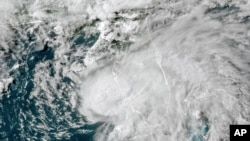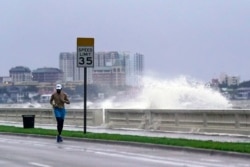National forecasters have increased their expectations of an above-average hurricane season over the Atlantic basin, according to a Wednesday briefing from the National Oceanic and Atmospheric Administration.
The updated seasonal outlook predicts that 15 to 21 named storms of 39 mph (63 kph) or greater will form, of which seven to 10 may become hurricanes with wind speeds of 74 mph (119 kph) or greater. Both predictions mark slight increases from the May forecast released by NOAA.
NOAA also expects this season three to five major hurricanes — hurricanes whose top winds reach 111 mph (179 kph) or greater.
“A mix of competing oceanic and atmospheric conditions generally favor above-average activity for the remainder of the Atlantic hurricane season, including the potential return of La Niña in the months ahead,” said Matthew Rosencrans, a hurricane forecaster at NOAA’s Climate Prediction Center.
Rosencrans put the likelihood of La Niña forming at roughly 50% for the remaining months of the season, which officially ends November 30. La Niña is a weather pattern that brings colder waters to the Pacific Coast and can also increase Atlantic hurricane activity.
An average hurricane season has 12 named storms, six hurricanes and three major hurricanes. If NOAA’s predictions prove true, 2021 will be the sixth consecutive year with above-average storm activity.
The 2020 hurricane season was the busiest on record, producing 30 named storms, including 14 hurricanes and seven major hurricanes. A record-breaking 12 storms, six of which were hurricanes, hit the U.S. coastline last year.
Rosencrans cited climate change as a factor for the increasing intensity of storms, noting that recent seasons have brought about 3% more rainfall with any given storm and wind speeds that are 10% higher than average.
“When you take a storm, and you have the climate change-induced sea-level rise, that does increase your threat for coastal flooding,” Rosencrans said.
Though the past few weeks have seen a lull in Atlantic storm activity, the beginning of the 2021 season started off aggressively, with Tropical Storm Elsa becoming the earliest fifth-named storm on record when it formed on July 1.
Elsa killed one Florida resident, injured several people in Georgia, and damaged vehicles and buildings in several states.
Drawing from 50 years of data, NOAA has found that early-season storm activity is not an indicator of the overall season, since most Atlantic storms form during the peak months of August, September and October.
NOAA did not predict how many storms in the 2021 season would make landfall, but it encouraged residents in hurricane-prone areas to get prepared ahead of peak hurricane season, which begins in August.
“Forecasters do anticipate that a busy hurricane season remains ahead. Now is the time to be vigilant about preparedness plans and potential actions,” Rosencrans said. “Regardless of your predicted activity, it does only take one storm to have catastrophic impacts on large communities.”






